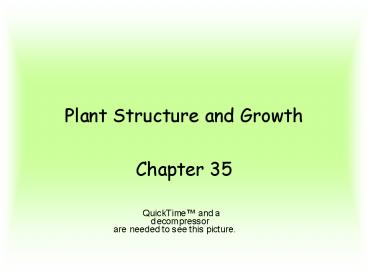Plant Structure and Growth - PowerPoint PPT Presentation
1 / 57
Title:
Plant Structure and Growth
Description:
Plant Structure and Growth Chapter 35 Plants with vascular tissue have 3 structures - roots, shoots, leaves. 2 groups of angiosperms, monocots and dicots, differ in ... – PowerPoint PPT presentation
Number of Views:79
Avg rating:3.0/5.0
Title: Plant Structure and Growth
1
Plant Structure and Growth
- Chapter 35
2
- Plants with vascular tissue have 3 structures -
roots, shoots, leaves. - 2 groups of angiosperms, monocots and dicots,
differ in structures.
3
(No Transcript)
4
- Structures divided into 2 systems root system
(below ground), shoot system (above ground). - Systems rely on one another roots - no
chloroplasts - need shoots to photosynthesize.
5
(No Transcript)
6
- Monocots (grasses) - fibrous root systems
(mat-like). - Dicots (flowers) - taproot system with one large
root. - Most absorption of water and minerals occurs near
root tips with root hairs - increase surface
area.
7
(No Transcript)
8
- Some plants - adventitious roots -arise
aboveground from stems or even from leaves. - In corn - help to keep plant upright.
9
http//homepage.smc.edu/hodson_kent/plant_growth/A
ngiosperms/ID/320root20systems.jpg
10
- Stems have nodes - leaves attached, internodes -
spaces between nodes. - Where leaves meet stems - axillary buds -
vegetative branch could form. - Terminal bud - growth of young shoot
concentrated. - If terminal bud present, growth happens
vertically - apical dominance.
11
http//utc.usu.edu/factsheets/CarexFSF/CIG/interno
des.jpg
12
Modified shoots
- 1Stolons - runners of strawberry plants - grow
on surface so that parent plant can asexually
reproduce in large numbers.
13
(No Transcript)
14
- 2Rhizomes (ginger) - horizontal stems - grow
underground. - 3Tubers (potatoes) - swollen ends of rhizomes
specialized for food storage. - 4Bulbs (onions) - vertical, underground shoots
consisting mostly of swollen bases of leaves that
store food.
15
Rhizomes
16
Tubers
17
Bulbs
18
- Leaves consist of flattened blade and stalk
(petiole) - Some leaves evolved other purposes (spines of
cacti for defense, leaves modified for water
storage, brightly colored leaves that attract
pollinators)
19
(No Transcript)
20
(No Transcript)
21
- Each organ of plant - 3 tissue systems dermal,
vascular, ground. - Dermal system consists of epidermis (covers,
protects) - Epidermis of leaves, most stems secretes waxy
coating (cuticle) - helps parts of plant retain
water.
22
http//www.naturescapes.net/042004/Figure3.jpg
23
- Vascular tissue involved in transport of
materials between roots and shoots. - 1Xylem tissue that conducts water and minerals
from roots to rest of plant. - 2Phloem transport nutrients, especially
carbohydrates produced in leaves down stem.
24
(No Transcript)
25
- 2 types of xylem cells vessel elements,
tracheids. - Dead at maturity - help to thicken walls to
promote water flow. - Tracheids - long, thin cells with tapered ends.
- Vessel elements - wider, shorter, thinner walled,
less tapered than tracheids.
26
(No Transcript)
27
- 2 types of phloem cells - companion cells, sieve
tube members. - Sieve tube members - tubes that material moves
through. - Companion cells assist sieve tube members.
28
(No Transcript)
29
- Ground tissue - tissue neither dermal nor
vascular. - Dicot stems, ground tissue divided into pith,
internal to vascular tissue, and cortex, external
to vascular tissue.
30
http//wpcontent.answers.com/wikipedia/commons/thu
mb/9/92/Stem-histology-cross-section-tag.svg/250px
-Stem-histology-cross-section-tag.svg.png
31
- 3 different types of plant cells parenchyma,
collenchyma, and sclerenchyma. - Parenchyma cells - primary walls that are
relatively thin and flexible typical plant
cells ex. sieve-tube members.
32
(No Transcript)
33
- Collenchyma cells -thicker primary walls than
parenchyma cells - used for support in growing
plants. - Sclerenchyma cells also function as supporting
elements of plant.
34
(No Transcript)
35
(No Transcript)
36
Growth of tissues in plants
- Annual plants complete life cycle in single year
or less. - Biennial plants - 2 years.
- Plants that live many years, including trees,
shrubs, and some grasses, are perennials.
37
http//www.btinternet.com/micka.wffps/foxglove12.
jpg
38
- Growth in plants due to embryonic cells
(meristems) - Elongate and differentiate into cell types
depending on tissue of plant.
39
http//pgjennielove.files.wordpress.com/2008/06/ap
ical_meristem.png
40
- Apical meristems found at tips of roots, stems -
allow for growth in length - only happens at
tips. - Primary growth occurs lengthwise, secondary
growth - widthwise. - Lateral meristems responsible for secondary
growth.
41
(No Transcript)
42
- Root tip protected by root cap to protect
meristem.
43
(No Transcript)
44
(No Transcript)
45
- Axillary buds have potential to form branches of
shoot system. - Vascular tissue runs length of stem in strands
(in vascular bundles)
46
(No Transcript)
47
- Leaf epidermis composed of cells tightly locked
together. - Full of stomata - controlled by guard cells
around that can open and close opening.
48
(No Transcript)
49
- Spongy layer of cells inside leaf has
chloroplasts with air spaces around cells. - Palisade layer in leaf has densely packed cells
spread over large surface area.
50
(No Transcript)
51
Lateral meristems
- 2 cambiums responsible for secondary growth.
- Vascular cambium - meristem to produce secondary
xylem and secondary phloem. - Cork cambium - meristem for tough, thick covering
for stems and roots - replaces the epidermis.
52
(No Transcript)
53
- As secondary growth continues over years, layer
upon layer of secondary xylem accumulates,
producing wood. - Actually dead cells.
- Growth in areas like Maine occur in cycles -
dormancy then growth -produce growth rings.
54
(No Transcript)
55
(No Transcript)
56
- Bark - all tissues external to vascular cambium
(secondary phloem, cork cambium, cork) - 2 types of secondary phloem heartwood and
sapwood. - Heartwood (hardwood) no longer conducts water
sapwood (softwood) functions in transport of
water and minerals.
57
(No Transcript)

